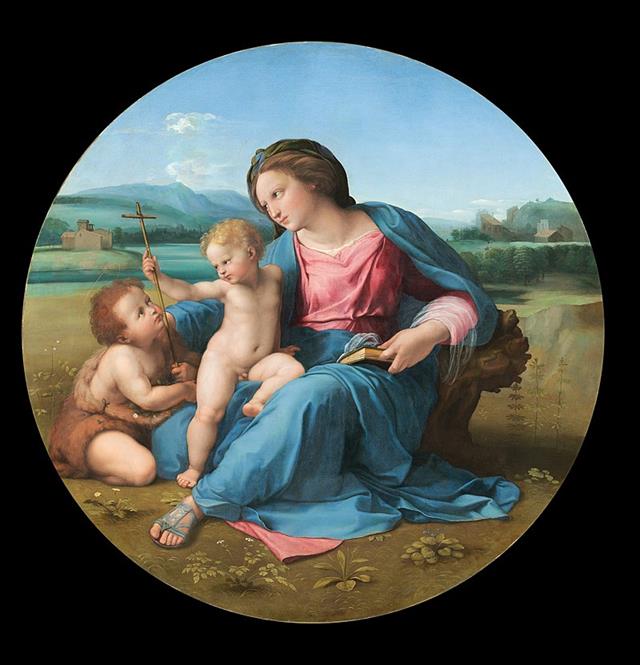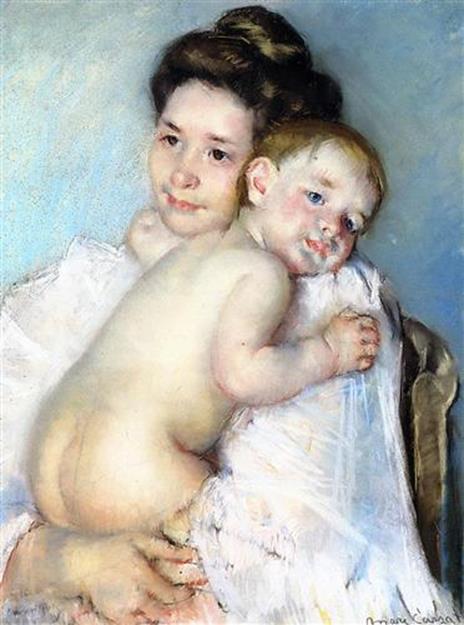
With Mother’s Day two days away, I am thinking of artworks that feature mothers. When I was a kid, everyone had heard of Whistler’s Mother, even though the painting is actually named Arrangement in Grey and Black No. 1. I don’t recall what I imagined the iconic painting would look like, but I when I first saw it, I was disappointed. Nothing going on in the scene, a woman dressed in black sitting in a gray room, looking straight ahead but not at me. Fortunately, not all artworks featuring mothers are so blah. So here are 4 Memorable Artworks about Mothers.
#4 Berthe Morisot’s The Cradle
Berthe Morisot was one of few recognized women artists. She was wealthy and supported fellow artists, opening her home as a meeting place. She was an established artist who showed in the official art exhibitions for years. She took a risk by placing The Cradle in the radical first Impressionist Exhibition in 1874, but it didn’t sell. Her family was finally able to sell it fifty-six years later in 1930.

In this painting, she presents her sister with her baby, Blanche. It shows a quiet moment in which the mother lovingly stares at her child, watching the baby sleep in its cradle protected by a net. She takes in the child’s innocence, peacefulness, and vulnerability. The net shows off Berthe’s skill in painting the gauzy fabric, but it also separates the baby from its mother, at least from our vantage point, and puts the mother in sharper focus. The firm structure of the painting reduces sentimentality. The mother is in deep thought, perhaps contemplating the ways in which her life will never be the same. For all the joys a baby brings, a sense of uncertainty, responsibility, and for some parents, obligation, is another side of the coin. Artworks like this open possibilities for multiple interpretations based on the artist’s handling and each viewer’s own experiences.
#3 Raphael’s Alba Madonna
Since so much art across the ages has religious themes, I imagine the mother who appears most often in artworks is Mary, the mother of Jesus. There are so many paintings of the annunciation, the moment when an angel announces to Mary that she will be Jesus’s mother. Another popular scene shows Mary’s visit to Elizabeth, the future mother of John the Baptist. Many others show Mary holding the infant Jesus.

This painting by Raphael in 1510 shows mother and child rendered in harmonious color and skillful drawing, evident even in the drapes of Mary’s clothing as she humbly sits on the ground. The faces are beautiful and delicate. The figures are placed in a natural setting that recedes so they are front and center, taking up most of the circular space (tondo). The inclusion of John (the future Baptist), Mary’s arm outstretched to him, and the three figures’ eyes fixed on the cross held by John at the moment when Jesus grasps it shows the bonds between them, and presages the roles each would play in the years to come.
#2 Michelangelo’s Pietà
The next artwork was made by Michelangelo Buonarrotti, so well-known that we refer to him by only his first name. His skill with marble is unmatched. It is amazing that he created this sculpture in 1499 when he was only 25 years old. In fact, Pietà (Pity) made him famous. 13 years later he painted the Sistine Chapel. Usually statues present noble, stoic, and symbolic views of their subjects. Think of a bust of George Washington, the Statue of Liberty, or Christ the Redeemer looking over Rio de Janeiro. So it is remarkable when an artist sculpts figures that portray not grand gestures but a quiet moment.

Mary cradles the lifeless body of her son Jesus after he was taken down from the cross. It could be a dramatic and gory scene. But instead, Jesus looks peaceful and his wounds are shown with subtlety. Even though Mary feels the devastation of a mother who has lost her child, we see tenderness, grace, and acceptance. This marble sculpture, unlike most statues, does not just show us someone; it makes us feel something, especially under dramatic lighting. The deep and delicate folds of her clothing make it hard to believe they are carved in stone.
It was shocking when a deranged man attacked the sculpture with a hammer in 1976, knocking off Mary’s arm and nose before he was tackled. People ran off with broken pieces, but returned most of them. Her nose was never returned.
#1 Mary Cassatt’s Mother and Child
Mary Cassatt, born into a wealthy family, attended the Pennsylvania Academy of Fine Arts. She moved to Paris when she was 24, continuing as a pioneer in the male-dominated art world. Like Berthe Morisot, her works were selected for official exhibitions; also like Berthe, she joined the Impressionists, making her the only prominent American in the group. Mary painted notable scenes like Lydia in a Loge at the opera, but most of her numerous paintings depict a mother and child.

Mary uses color and decorative patterns to capture tender, peaceful domestic moments, allowing us to feel the bond between mother and child. In The Child’s Bath from 1893, the mother holds her child at the waist, her cheek gently touching the child’s shoulder, as she protects and cares for her child. Mary’s handling of the subject tells me that if she painted The Cradle, there would be no question about what the mother is thinking and feeling.
I was going to end my post here, but I have to share one more Cassatt because it includes perhaps the most captivating baby’s face in all of art. Here is Mother Berthe Holding Her Baby.


The Pieta is always so powerful. I loved this theme.
Well done!